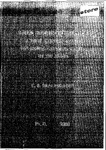METAL BIOGEOCHEMISTRY OF A MINE CONTAMINATED EsTUARiNE-CoASTAL SYSTEM IN SW SPAIN
| dc.contributor.author | BRAUNGARDT, CHARLOTTE BARBARA | |
| dc.contributor.other | Faculty of Science and Engineering | en_US |
| dc.date.accessioned | 2012-08-02T09:27:29Z | |
| dc.date.available | 2012-08-02T09:27:29Z | |
| dc.date.issued | 2000 | |
| dc.identifier | Not available | en_US |
| dc.identifier.uri | http://hdl.handle.net/10026.1/1075 | |
| dc.description.abstract |
The aim of this project was to investigate the biogeochemistry and transport of metals in a river/estuarine system contaminated by acid mine drainage. The Rio Tinto and Rio Odiel drain a metalliferous mining area in the Iberian Pyrite Belt in the south-west of Spain. The pH values in the rivers were low (< 3) and dissolved metal concentrations were . extremely high, up to 2.6 mM Zn, 860 \M Cu, 6.0 jaM Cd and 72 nM U . The seasonal cycle of low precipitation and flash floods was identified as an important factor in generating the more severe contamination of the rivers with Fe, A l , Mn, Zn, Cu, N i , Co and Cd observed during autumn and winter, compared to spring and summer. The estuarine behaviour of dissolved Fe, Mn, Zn, Cu, N i , Co and Cd was primarily = controlled by pH. Apart from an addition of these metals from the sediment in the upper Tinto estuary, conservative mixing was observed up to pH ~ 5 (at S ~ 30), above which Fe, Mn, Zn, Cu, N i and Co were removed from solution. Voltammetric speciation studies showed that Cu complexing organic ligands (logK'cuL ~ 11-5, CL = 32 - 199 nM) in the estuary were saturated, and thermodynamic calculations indicated that the concentration of Cu^"^ reached values (pCu^"^ < 9) that are toxic to some marine and estuarine organisms. The estimation of fluxes indicated that the dissolved metal export from this system to thecoastal zone averages 101 d'^ Zn, 2.3 t d"' Cu, 180 kg d"^ N i and 236 kg d"^ Co, with higher contributions during wet, compared to the dry seasons. On-line measurements of Zn, Cu and N i in the Gulf of Cadiz revealed metal plumes associated with the Tinto/Odiel system and the Guadiana and Guadalquivir rivers. As a result of entrainment by the Atlantic Ocean surface current flowing into the Mediterranean Sea, the metal contamination in waters of the Gulf of Cadiz is transported south and eastward. | en_US |
| dc.description.sponsorship | Faculty of Science | en_US |
| dc.language.iso | en | en_US |
| dc.publisher | University of Plymouth | en_US |
| dc.title | METAL BIOGEOCHEMISTRY OF A MINE CONTAMINATED EsTUARiNE-CoASTAL SYSTEM IN SW SPAIN | en_US |
| dc.type | Thesis | |
| dc.identifier.doi | http://dx.doi.org/10.24382/3341 |
Files in this item
This item appears in the following Collection(s)
-
01 Research Theses Main Collection
Research Theses Main


